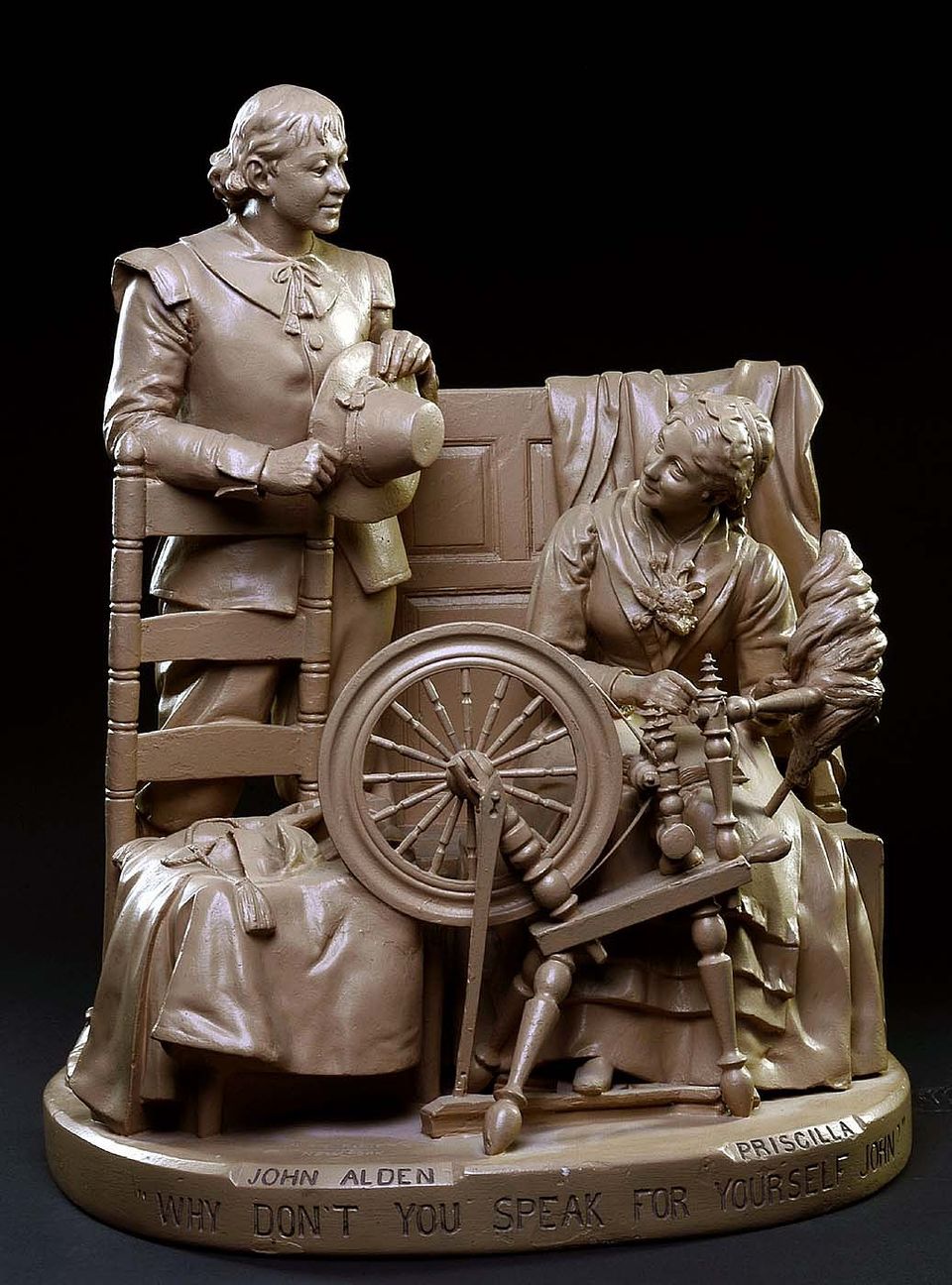
This post is part of an ongoing series on Eye Level: Q and Art, where American Art's Research department brings you interesting questions and answers about art and artists from our archive.
Question: Can you tell me more about the story portrayed in John Rogers' sculpture "Why Don't You Speak for Yourself, John?"
Answer: John Rogers was just one of the many artists who contributed to our mental image of the Pilgrims through his portrait of John and Priscilla. His sculpture illustrates a scene from Henry Wadsworth Longfellow's poem The Courtship of Miles Standish, which tells the story of a love triangle between three members of the Plymouth Colony: Captain Miles Standish, John Alden and Priscilla Mullins. The poem begins by introducing the friends Captain Miles Standish and John Alden. John is portrayed as scholarly, reserved and handsome. He is writing letters in which he frequently mentions Priscilla, barely hiding his secret love for her. Miles is older, brash and pompous. He recounts his past accomplishments in war and compares himself to Julius Caesar. We learn that his wife has died during the winter, and he has decided to remarry. The woman he has in mind is the "the Puritan maiden Priscilla". Because he is afraid of rejection, Miles convinces John to speak to Priscilla on his behalf.
Priscilla is working at her spinning wheel and singing Psalms when John arrives at her home. He wishes he had mentioned his affection for her during a past visit but realizes that he missed his chance and quickly bursts out with the Captain's desire to marry her. The surprised Priscilla asks why Miles cannot come and woo her himself, and after John goes on about the virtues of his friend, Priscilla says her famous line, "Why don't you speak for yourself, John?" It is in that moment that John understands that Priscilla returns his affection.
John is torn between his loyalty to his friend and his love for Priscilla, and he decides that he will return to England on the Mayflower, which is to set sail the next day. He returns to Miles and tells all that was said in his interview with Priscilla, and Miles angrily accuses him of betraying their friendship. In the middle of his tirade, Miles is called away to discuss threats to the colony. The next morning, Miles prepares for battle. John wishes to speak to his friend, but pride keeps him quiet.
John goes to the beach to board the Mayflower, however, when he sees Priscilla among the colonists who have gathered to watch the ship depart, he decides that he cannot leave her. She later finds him lingering at the shore and the two discuss their previous conversation. When news of Captain Standish's conquests during the battle with the Indians arrives at the village, Priscilla is horrified and dreads the day Miles will return and repeat his offer of marriage. Months later, John and Priscilla are at her spinning wheel, when a messenger arrives with news that Miles has been killed in battle. John is saddened by the death of his friend, but he also feels the freedom to marry Priscilla. The two fall into each other's arms. On the day of the wedding they are surprised by the return of Miles, who had not died as reported. After the vows are exchanged the Captain steps forward to say that all is forgiven. The colonists celebrate the wedding and the return of Captain Standish. Then they return to their work, and John guides Priscilla to their new home on the back of a snow-white bull.
Longfellow published The Courtship of Miles Standish in 1858, more than two hundred years after the Pilgrims landed in Plymouth in 1620. John Alden, Priscilla Mullins and Miles Standish were passengers of the Mayflower; however, the Plymouth Colony records do not document any of the details of the romance between John and Priscilla. Historians know that John and Priscilla were married had ten children, but the truth of the rest of the legend is impossible to confirm. It was not until 1815 that the first written version of the romance appeared in Timothy Alden's A Collection of American Epitaphs and Inscriptions with Occasional Notes. Longfellow, who was a descendant of John and Priscilla Alden, claimed that the story of the courtship was passed down through his family.
For additional information about John Rogers' sculpture look for the following exhibition catalog at your library or bookstore: John Rogers: American Stories, edited by Kimberly Orcutt, New York: New York Historical Society, 2010. To learn more about the lives of the Pilgrims visit the Plimoth Plantation and Pilgrim Hall Museum websites.


















